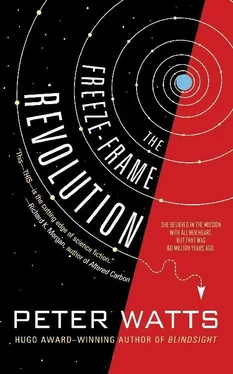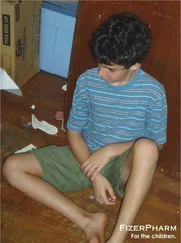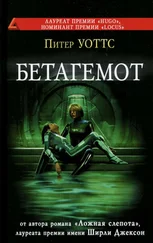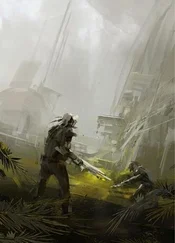“What happened?” the Chimp said.
“What does it look like? The forest attacked hir. It attacked me. Gone completely fucking feral.”
Kaden had nothing to add. Spinal blocks can be distracting at the best of times.
Chimp: “How?”
“A couple of mutations left to simmer for fifty thousand years, that’s how.” We started back up the corridor. “Don’t ask me to go back in after Dao.”
“Why not?”
“Because there’s not enough left of him to make it worth the risk. Send a bot if you want him so bad.” A calculated risk, but Chimp wasn’t the impetuous sort. At the very least it would wait to hear my report.
“Sunday.” IF vocal stress harmonics > X THEN invoke name. DO UNTIL calm.
“What.” Into the tube. There was an infirmary a couple of levels up. Probably unnecessary—the gurney could handle a simple flesh wound—but the system was programmed to play it safe under incomplete-information scenarios.
“You’re injured too.”
“I’m okay. I’ll glue myself together upstairs.”
Satisfied, it moved on. “Can you explain how low -lumen photosynthesis could generate enough energy to support such rapid movem—”
“Look up turgor , for fucks’ sake. Those vines had gigasecs to build up hydrostatic pressure. Released it all in a split-second. Lucky it didn’t take hir whole leg off.”
The hesitation was so slight I barely noticed it; the Chimp could have run a thousand scenarios in that time. “That would account for initial damage along any given route. But there wouldn’t be enough time to re-establish turgor pressure between multiple incursions along the same path.”
Out of the tube and a few kilos lighter. Kaden’s gurney slid on ahead. I lingered a moment, distracted by a new scrawl of swirls and jiggles and dots ( new— now there’s a relative word) the Painters must have left sometime over the past few millennia. I wondered distantly what they meant. That word popped into my mind again: feral .
“Sunday.”
“I know.” I picked up the pace, lowered my voice enough to release the Chimp from DO UNTIL. “Obviously they’re not being powered by the usual redox reactions.”
“Do you know what they could be using instead?”
I did. But it wouldn’t do to make it look too easy. Lian had cut me a tissue sample while we’d been catching up; I pulled it from my belt. “Let me run this. Then we’ll talk.”
The in firmary was less compartment than cul-desac, an invagination of corridor containing a hardlined sarcophagus and two gurney sockets. A lab bench nestled in their midst, a horseshoe of screens and sample ports curved around a pseudopod. The sequencer was primarily intended for human tissue, but everything’s the same tinkertoy that far down. It only took a few minutes to extract the genome; maybe another twenty to extrapolate the resulting phenotypes. By the time I was finished Kaden had decided to sleep through the mandatory sixteen-hour convalescence window and availed hirself of the general anesthesia option. Chimp and I were alone again.
Not exactly a Sunset Moment.
“It’s a gradient pump,” I said.
“I see.”
Maybe it did, or maybe it was flowchart filler. “Any gradient would work, in principle. Ionic, thermal, gravitic. Any time you’ve got energy flowing from A to B, you can siphon some off in between.”
“Gravitic,” the Chimp guessed. Maybe not filler after all.
“Yeah. Glade’s right above the Higgs Conduit, right? There’s a gravity gradient—in some spots it’s so strong the tree trunks actually spread out to handle simultaneous vectors from different directions. And these sequences”—I gestured at the workbench display—“seem to code for a metabolic chain that exploits that gradient.”
“I have no records of any such processes ever evolving on Earth.”
“Why would they? Back on Earth you could have a single organism stretching from sea level to the edge of space and the raw gradient would barely be competiti ve even if you could figure out some way to make Krebs cycle work across a few hundred kliks.” Just say the lines. “But everything’s squashed here, right? You’re going from one gee to a thousand in the space of fourteen kilometers, and that’s before you split your center of mass in two.” Don’t pause. Don’t hesitate. Don’t leave any opening for but s or what-if s. “Whole different set of rules. More energy. Everything from tissue growth to waste-O 2production amps up.”
They were good answers, plausible answers. True answers, even. But each question I answered might incite others; each follow-up would make it that much harder to keep the flowchart veering toward evolution and away from engineering .
The silence stretched. I resisted the urge to hold my breath. It all came down to cost-benefit, to the number of layers the Chimp would peel back before diminishing returns told it to take the rest on faith.
“Do you have any recommendations?” it asked at last.
I resisted another urge: to slump, this time, to relax. To realize that our Earthbound progenitors had done th eir job well.
For all the blinding speed with which it could count on its fingers, the Chimp just wasn’t very smart.
I started at the extremes, let the flowchart talk me back to the middle.
“We could leave it alone. It’s still doing its job and the mutant cycle only works across extreme grav gradients anyway, so we don’t have to worry about it popping up anywhere else. Maybe we should just stay out of its way.”
Two corsecs; a thousand scenarios. “Operational variance is too high. There are too many unquantified variables in the Glade for reliable long-term management.”
A creature of confidence limits, this machine. Couldn’t abide anything more than two standard deviations off the mean .
“Then torch the place. Burn it to bedrock.”
Only one corsec this time; a simpler simulation, all those complicating variables turned to ash. “That would reduce life-support capacity by eight percent.”
“Reseed afterward. We could take an eight percent hit for a few centuries.”
“There’s no guarantee the mutation wouldn’t reappear.”
“Not with the original genome, no. Not unless we shut down the gradient so it couldn’t get a foothold.” Which would, of course, mean shutting down the drive. Like the Chimp would ever go for that in a billion years.
“We could modify the local genome,” it suggested.
“We could,” I admitted, as though I were only now considering it. “Break a few S-bonds, straighten some kinks to allow the edits. Maybe seed a retrovirus up front to slow growth. Buy us some time to gene-drive a proper fix.”
This time the pause went on forever. “I can’t calculate how long that would take.”
“’Course not. Genes are messy, they interact all over the place in a single cell . We’re talking about a multispecies ecosystem with precise operational constraints. You’d have better luck asking me for hard numbers on a three-digit N-body problem.”
“But it can be done.”
“Sure, through trial and error. Tweak one variable, let it cook, correct for overshoots and chaotic interactions, repeat.”
“How long to cook?”
“You in a hurry?”
“I’d like to restore equilibrium as soon as possible.”
“If you’re impatient we could do it all right now. Edit the hell out of the whole forest in a single generation. Just don’t expect me to deal with the second- and third-order interaction effects that’ll be cropping up every few megasecs, guaranteed.”
Читать дальше










![Питер Уоттс - Водоворот. Запальник. Малак [litres]](/books/420290/piter-uotts-vodovorot-zapalnik-malak-litres-thumb.webp)